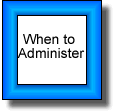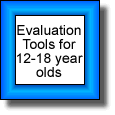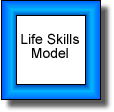 |
|||||||||
 |
|||||||||
 |
|||||||||
 |
|||||||||
 |
|||||||||
Communication: Teaching Resources
Activity #1 – Barriers to Effective Communication
The group discussed obstacles to good communication, listing no eye contact (inability to read
nonverbal cues), distance, no feedback, bad listening skills, environmental noise, etc.
Four delegates volunteered to sit in pairs, facing opposite directions. In the first round, they were
to “interview” each other at a distance of three feet, for 30 seconds. In the second round, the distance
was increased to 20 feet, and they were given 60 seconds for their interview. In the first two rounds, the
pairs were instructed to ask each questions only once, regardless of the need for clarification. The pairs
were rearranged to face each other for the third round, still at a distance of 20 feet. They were then given
15 seconds to complete their interviews, and this time they were allowed to repeat their questions if
needed for clarification.
Following the activity, the group discussed the issues which made this situation difficult. Members
listed issues such as the inability to clarify answers, get or give feedback, monitor nonverbal cues, or
monitor eye contact for understanding. They also discussed the issue of environmental factors as
barriers, given the distance between the two volunteers, as well as increased noise.
Activity #2 – Drawing pictures
The delegates were divided into two groups for this exercise, and a leader was appointed for
each group. Each leader was given a picture to explain to their group, as group members try to duplicate
the picture on their individual papers. Instructions were given to each group as follows:
Group A:
• Only leader talks.
• Members of the group can look at each other’s papers, but leader cannot see group
members’ papers.
• Group members cannot ask questions or give any sort of feedback.
• Leader and group members cannot use hand gestures of any sort.
Group B:
• Free talking is allowed as needed.
• Questions are allowed at any time.
• Hand gestures are allowed at any time.
• The only restriction is that no one is allowed to see another person’s picture, including
the leader.
At the conclusion of the activity, all group members turned in their papers, and were allowed to look at the
original drawing. Overall, Group B drawings were much closer to the original than were those from Group
A. The group then discussed the importance of using hand gestures (nonverbal communication) in
interactions, as well as the importance of interaction management (the ability to control the flow of
information).
Activity #3 –Parallel Thinking
Learning objective: To illustrate the need for accurate communication.
Procedure:
1. Tell the group that you are going to write a word on the board, and they are then to write the first word
that comes into their minds.
2. Every five seconds, say “Write.” Group members should then write the next word that pops into their
minds on the same topic.
3. Proceed for one minute with each member accumulating a list of words.
4. Go around the room and have each member read the last word on her or his list.
Results will illustrate that within the one area everyone’s thoughts on the same topic proceeded in many
different directions. Possible discussion topics following this activity are:
• the various backgrounds everybody brings to the communication process, which affects how
they communicate and understand what is being communicated,
• the importance of feedback for understanding,
• this exercise began with just one word, and went in so many different direction – imagine how
confusing everyday communication is, with the addition of more words, complicated words,
more sentences, words with different meanings, words that can imply different feelings, etc.,
• the importance of checking for accuracy when managing the communication interaction,
• others.
Adapted from: Jacobs, M., Turk, B., & Horn, E. (1988). Building a positive self-concept: 113 activities for
adolescents. Portland , ME : J. Weston Walch.
Activity #4 –Who’s Listening
Learning objective: To understand how and why communication sometimes fails.
Procedure:
1. Pair up group members. Say, “Go!” Both members talk simultaneously on any topic for thirty seconds.
2. Say “Stop!” Each member talks briefly to his or her partner about the feelings experienced while the
partner was not listening.
3. “Go!” One of the partners talks on any topic while the other listens.
4. “Stop!” Partners share feedback, feelings, and perceptions about what happened.
5. “Go!” The other partner gets to talk while the first talker listens.
6. “Stop!” Feedback.
Follow this activity with a discussion about feelings and perceptions about the procedures. Talk about the
difference between talking and listening, and explain why each is important to effective communication.
Variations on this activity include instructing one person talk while the other stares out the window, or
does another activity without paying attention to the talker, etc. This also illustrates the purpose of
listening. Another variation is to teach a lesson on the process of active listening, and include that as an
instruction in this activity. Group members could then compare and contrast their feelings when they
weren’t listened to, when they were passively listened to, and when they were actively listened to, etc.
Adapted from: Jacobs, M., Turk, B., & Horn, E. (1988). Building a positive self-concept: 113 activities for
adolescents. Portland , ME : J. Weston Walch.
Activity #5 –String Together
Learning objective: To practice group communication that includes everyone.
Procedure:
1. Set up a topic for discussion. It may be a topic on communication, or something else relevant to the
group.
2. Divide the group into groups of six and give each group a ball of string.
3. As the discussion proceeds, each person can talk only when he or she is in possession of the ball of
string.
4. When the next person speaks, the ball is unraveled to that person.
5. Eventually a pattern emerges. Participants can see who is dominating and who is not contributing to
the discussion.
Topics of discussion to follow this activity include:
• Different communication styles, and how they influence the communication process,
• The importance of managing the interaction,
• The important contributions that everyone has to make in any situation,
• How the group members felt when they recognized the pattern, and found that they were dominant,
not contributing, etc.
Adapted from: Jacobs, M., Turk, B., & Horn, E. (1988). Building a positive self-concept: 113 activities for
adolescents. Portland , ME : J. Weston Walch.
Activity #6 –Feedback Circle
Learning objective: To encourage listening and to recognize one’s own style of communicating.
Procedure:
1. Break group members into groups of four.
2. One person talks nonstop for thirty seconds about anything.
3. The other three group members then each make a statement about what they heard.
4. They also each make a statement about a nonverbal observation such as body language, motivation,
or facial expression.
5. Discuss how the verbal and nonverbal messages come together to give the listener an impression of
the speaker.
Topics of discussion to follow this activity include:
• The powerful impact nonverbal behaviors have in the communication process.,
• Strategies to adjust your style of communication,
• The importance of feedback,
• When spoken messages and nonverbal messages agree or contradict each other,
• etc.
Adapted from: Jacobs, M., Turk, B., & Horn, E. (1988). Building a positive self-concept: 113 activities for
adolescents. Portland , ME : J. Weston Walch.
Activity #7 –What Did You Say?
Learning objective: To help group members realize that listening well (receiving messages) and speaking
clearly (sending messages) can be difficult and takes concentration, and a willingness to learn the
specific skills of “sending” and “receiving” messages.
Procedure:
Have five or six group members step outside the room. The rest of the group, with your help, should
come up with a “wild” made-up short story. Have a member of the group record the main details of the
story.
Ask one of the members you’ve sent outside to come in and tell that person the group’s story. That
person, in turn, tells the next member who comes in, who in turn tells the next student, and so forth. By
the time the last student tells the story, it is usually mixed up, very unclear, with many details missing.
Next, ask: “What was the problem?” Usually, students were either not receiving clearly or sending
clearly.) This discussion can be focused around the importance of listening or of sending messages
accurately, or both. Discuss the roles of the sender and the receiver in the communication process, and
how each role is crucial to the communication of accurate information.
Variation: Teach the components of active listening after this process has been done once, then do it
again, directing each member who comes in from outside to practice active listening. the results of this
round can be compared and contrasted to those of the first round. Usually, the story will still have some
minor changes when active listening is practiced, but not like the changes made in the first round.
Closure: Remind members how communication can be difficult if the sending and receiving of messages
is unclear.
Adapted from: Wittmer, J. & Thompson, D. W. (Eds.). (1995). Large group guidance activities: A K-12
sourcebook. Minneapolis , MN : Educational Media Corporation.
